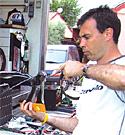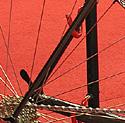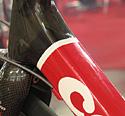
 |
 |
 |
 |
 |
 |
 |
 |
Bicycling Australia Show
Sydney, Australia, October 21-23, 2005
Main Page Previous Part Next Part
Part 2: Cervelo - lighter, stiffer, stronger
For a relatively small show in one of the world's smaller bike markets, the Bicycling Australia expo had a surprising number of visitors making the long haul from Europe or the USA, giving local riders and dealers a chance to get the word on their new gear straight from the source. One such visitor was Cervelo's Phil White, who gave John Stevenson a detailed insight into three of the company's new bikes.

|
Cervelo has three key new bikes for 2006 and you wouldn't think you could get an extensive tour of just three bikes. You wouldn't, unless the person giving you the tour was Phil White. Like his co-founder at Cervelo, Gerard Vroomen, White is a voluble enthusiast for Cervelo's bikes, and delights in explaining the small and large details that set Cervelo apart.
Soloist Carbon
We started out with a bike that's not quite new, although it was only introduced in July of this year at the Tour de France. The Soloist Carbon is the bike that, as White proudly puts it, "Jens Voigt rode into yellow," on stage 9 of this year's Tour. And it ended up being the bike of choice for CSC for the Tour.
Before the Soloist Carbon was introduced, CSC riders had a choice - a light bike (the R2.5) or an aerodynamic one (the aluminium Soloist). "The idea was to combine both in a 1050g frame that's stiffer than the R2.5 but with aero advantages," said White. "That way there's no need to use anything else."

|
Although it's not the lightest frame in existence - or even the lightest that Cervelo makes - the Soloist Carbon was the basis of the lightest bike at the Tour de France, as measured by French magazine Le Cycle. The magazine measured Luke Roberts' Soloist Carbon at 6.9kg. CSC's 2005 bikes were also lighter than its 2004 bikes, according to Le Cycle's numbers - Denis Menchov's Colnago was the only other bike measured under 7kg and lighter than last year.
Between its low weight and the aero advantages of its tube shapes, White says he feels justified in making a bold claim about the Soloist Carbon: "This is the fastest road bike you can buy," he says.
Pressed to justify that, White concedes that Cervelo hasn't tested the complete bike in the wind tunnel, "but many elements were tested in the wind tunnel during its development," and feedback from CSC indicated riders felt the bike was fast.
Speaking of wind tunnel testing, White was eager to stress that Cervelo has its own take on using the tunnel as a development tool. "A lot of companies take a design to the tunnel to validate it, but you have to use the tunnel in development. I am always amazed at the use of the wind tunnel in marketing and not development. That misses the whole point."
R3 Team

|
If the Soloist Carbon is the only bike you need for most road racing situations, then Cervelo has put a hell of a lot of work into the second of its major 2006 introductions, the R3 Team. But this, the successor to the R2.5, is a bike for those moments when weight and stiffness are crucial. The R2.5 was introduced three years ago and has clocked up four Tour de France stage wins. "We've learned a lot in three years," said White, and Cervelo has attempted to distil all that knowledge into this 850-gram frame.
"The goal was to be lighter and stiffer than the R2.5," said White. In effect, the R3 Team is the bike formerly known as the R2.5 Bayonne. In developing the Bayonne, Cervelo kept finding ways to tweak, lighten and improve the frame, until it was no longer the same bike. Time for a new name. Nevertheless, "everything we learned from the [R2.5 Bayonne] project is in this bike," said White.
"A lot of finite element work went into this bike," said White, explaining how Cervelo's engineers had come up with a wide range of tube shapes throughout the frame. The down tube, for example, is a squared oval - or "squoval" - just behind the head tube for lateral rigidity, while the seat tube is asymmetrical.

|
"Every tube is designed for the forces it sees," said White, and that's most noticeable with the minimal seatstays. By the time Cervelo had beefed up the chainstays - "even bigger than the Soloist's," said White - there wasn't much more than a compressive load going up the seatstays, so there was no need for them to be very big.
Nevertheless, Cervelo believes the R3 Team will be stiff. "It matches the stiffest bike measured by [German bike magazine] Tour and will also be the lightest bike they've tested." A 56cm frame will weigh 850-870g, White said.
He's also confident that the R3 Team will be strong, despite its low weight. "If you are going to make a bike in carbon you've got to get it right because carbon is only strong in one direction. A lot of companies are just treating it as black aluminium," said White. The Japanese Industry Standard (JIS) test for frame strength in frontal impact involves a 50lb weight dropped on to the fork from 180mm. "We put in a solid steel fork and drop 50lb from greater and greater heights," said White. "This frame broke at four times JIS."

|
The R3 Team also features Kevlar reinforcement in the head tube so even in the seemingly unlikely event of a failure, there is material there to hold the frame together long enough for the rider to stop. "As far as I know we are the only ones to work on safety in this way," said White. "With the R3 Team we were aiming to be the lightest, strongest and stiffest."
P2C
Cervelo's final 2006 introduction is the P2C, a carbon fiber time trial and triathlon bike. This is a less expensive version of the P3, with a cut out seat tube instead of the curved tube of the P3, but retaining the P3's deep aero tubes. "We wanted to do a better execution of a concept Cervelo pioneered," with the P2, said White, pointing out that the seat tube tracks the shape of the rear wheel for a longer arc than most similar bikes. "It doesn't have the breakthrough coverage of the P3 but it's better than other dual-aero-and-cutout designs," said White.

|
The CSC factor
It's obvious talking to White that Cervelo's relationship with the CSC team is something the company values immensely. Cervelo has grown considerably over the last few years and now has a staff of 25, a third of them in the engineering department, but, "We're still the smallest bike maker in the ProTour," said White.
It's therefore doubly sweet for Cervelo that CSC was the top team in the ProTour this year. "It's nice to be with the top team and CSC has been great to work with," said White. "Jens in particular gives us lots of feedback, asking for more stiffness."
But what even CSC don't get from Cervelo is custom frames. "The riders all ride stock bikes," said White. "We told Riis 'we can't do custom bikes'," right at the beginning of the company's relationship with the team.
"He realized the didn't need custom bikes," said White. "The way we make bikes it's pretty much impossible. We've validated the design of the bikes with the team. If a guy is right off the charts when we can't accommodate him," said White.
But other companies can, and while White's quite happy to exist alongside carbon bike manufacturers who will tackle custom, he is dubious about the bikes some of them have been showing. "Some companies are going to do it well," he said, citing Massachusetts builder Parlee Cycles as one whose work he admires. "But some other systems may not work very well and are likely to end up heavy."
Photography
For a thumbnail gallery of these images, click here
Images by Cervelo
- Cervelo's Phil White in action at the Tour de France
Images by John Stevenson/Cyclingnews.com
- Cervelo P2C - the latest incarnation of Cervelo's original aero ideas.
- P2C cut-out closely follows the line of the tyre for maximum fairing effect.
- Cervelo R3 Team - the successor to the Bayonne is Cervelo's "lightest, stiffest, strongest"
- Skinny seatstays - the R3 Team ended up with minimal tubes in back
- Beefy front end - The R3 team will take four times the JIS test for frontal impact.
- Huge bottom bracket - Cervelo's aim was to make the R3 extremely stiff against pedaling and torsional forces.
- R3 chainstays go from square at the BB to round further back.
- "Squoval" is the term White uses for the rounded-square shape of the R3's down tube, which is intended to resist sideways forces for steering precision.